外研版英语八年级教案
- 格式:doc
- 大小:15.41 KB
- 文档页数:7
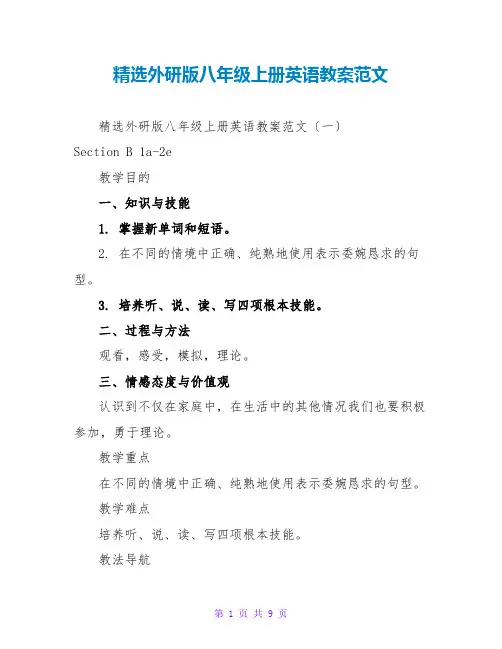
精选外研版八年级上册英语教案范文精选外研版八年级上册英语教案范文〔一〕Section B 1a-2e教学目的一、知识与技能1. 掌握新单词和短语。
2. 在不同的情境中正确、纯熟地使用表示委婉恳求的句型。
3. 培养听、说、读、写四项根本技能。
二、过程与方法观看,感受,模拟,理论。
三、情感态度与价值观认识到不仅在家庭中,在生活中的其他情况我们也要积极参加,勇于理论。
教学重点在不同的情境中正确、纯熟地使用表示委婉恳求的句型。
教学难点培养听、说、读、写四项根本技能。
教法导航创设情境,理论演练。
学法导航通过听说读写,独立考虑,小组合作完成学习任务,进步各项才能。
教学准备图片,多媒体。
教学过程Step 1 GreetingsGreet the students as usual.Step 2 PreparationT:When I was a teenager,my parents often asked me to clean my room. Sometimes they asked me to buy some things. Now I often ask my daughter to take out the trash. What chores do your parents usually ask you to do?S1:My mother usually asks me to buy some food.S2:My mother often asks me to make my bed.S3:My father always asks me to clean my bike.S4:They ask me to clean my bedroom.T: Do you ask your parents to do anything? What do you ask them to do?S1:I ask my mother to make bed for me.S2:I ask my father to buy some books for me....Step 3 PracticeT:Look at the items in 1a,Section B. What can teenagers ask their parents to do? Whatdo parents ask their teenagers to do? Write “parents” or “teenagers” next to each phrase.Ask students to go through the phrases first. Give some explanations about the key words.teenager:someone who is between 13 and 19 years oldsnack:something eaten between mealsborrow:borrow sth from sbinvite:invite sb to sth 〔a wedding, party,meal, etc.〕; invite sb to do sthThen check their answers.Step 4 Pair workLet students use the phrases in activity 1a to make conversations between parents and teenagers. First,get a pair of students to read the sleconversations. Then students make their own conversations.Step 5 Listening1c, T:Now listen to the conversation between Sandy and her mom. Please check each item in activity1a they talk about. Put a check mark in front of each phrase you hear.Play the recording,students only listen.Play the recording a second time. Students listen and check the items.Check the answers with the whole class.Play the recording a third time. Ask students to write down the things the three people are going to do. Pause the tape where necessary. Then check the answers.Step 6 Pair work1e T:Suppose you are having a party. Make a listof things you need to do. Some things are already given. Write more things you need to do. Get students work in pairs and add more things to the list. For exle:buy some CDs,decorate the walls,make somegifts ...T: Now make conversations and ask your partner to do some of the things for you. Then ask some pairs to demonstrate their conversations.Step 7 DiscussionSay:Doing chores has advantages and disadvantages. What’s your opinion? Ask some students to reporttheir opinion. Then say:Suppose you are Ms. Miller or Mr. Smith,after reading the two letters,work in groups and discuss the advantages and disadvantages of doing chores. After a few minutes,ask some groups to report their opinions.Step 8 ReadingSay:Read the letters again and try to find outthe phrases in 2d. Ask some students totranslate the phrases first and then ask them to work in pairs to write one sentence with each phrase from the letters. Then ask some students to report their sentences.Step 9 Homework1. Finish the chart in 2c according to Ms. Miller and Mr. Smith.2. Discuss the questions in 2e with a partner.精选外研版八年级上册英语教案范文〔二〕 Module 8 Around townUnit1 How do I get to the Forbidden City?〔1-4〕教学设计外研版八年级〔上〕一、教材分析^p :本模块以出行旅游为话题,通过大量的语言材料集中展示了问路、指路、对某一区域进展描绘的语言表达方式。
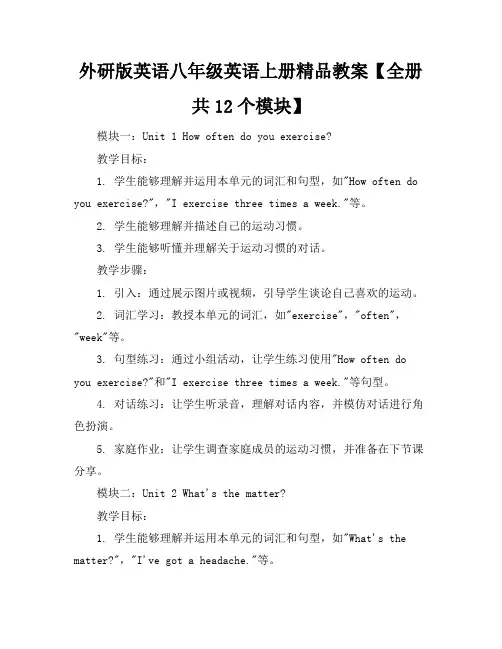
外研版英语八年级英语上册精品教案【全册共12个模块】模块一:Unit 1 How often do you exercise?教学目标:1. 学生能够理解并运用本单元的词汇和句型,如"How often do you exercise?","I exercise three times a week."等。
2. 学生能够理解并描述自己的运动习惯。
3. 学生能够听懂并理解关于运动习惯的对话。
教学步骤:1. 引入:通过展示图片或视频,引导学生谈论自己喜欢的运动。
2. 词汇学习:教授本单元的词汇,如"exercise","often","week"等。
3. 句型练习:通过小组活动,让学生练习使用"How often do you exercise?"和"I exercise three times a week."等句型。
4. 对话练习:让学生听录音,理解对话内容,并模仿对话进行角色扮演。
5. 家庭作业:让学生调查家庭成员的运动习惯,并准备在下节课分享。
模块二:Unit 2 What's the matter?教学目标:1. 学生能够理解并运用本单元的词汇和句型,如"What's the matter?","I've got a headache."等。
2. 学生能够理解并描述自己的健康状况。
3. 学生能够听懂并理解关于健康问题的对话。
教学步骤:1. 引入:通过展示图片或视频,引导学生谈论健康问题。
2. 词汇学习:教授本单元的词汇,如"matter","headache","toothache"等。
3. 句型练习:通过小组活动,让学生练习使用"What's the matter?"和"I've got a headache."等句型。

新外研版八年级下册英语全套优质教案第一单元:Making ChoicesLesson 1: What Would You Do?教学目标:- 学生能够运用所学的知识和经验在特定情境下作出明智的决策。
- 学生能够用英语描述并对比不同的选择。
教学准备:- 描述决策的图片或故事。
- 学生小组讨论活动的材料。
教学流程:1. 引入:通过展示图片或讲述一个故事,向学生介绍一个决策情境。
2. 学生小组讨论:以小组为单位,让学生讨论并给出自己的决策和理由。
3. 整体讨论:引导全班讨论,学生分享各自的决策和理由。
4. 规则制定:引导学生总结出在进行决策时需要考虑的规则和原则。
5. 练活动:给学生提供一些具体的情境,让他们以小组为单位进行活动,并运用所学的规则和原则作出决策。
6. 活动总结:回顾学生的决策过程及结果,并引导学生对比各种决策的结果及影响。
7. 练活动扩展:要求学生在家庭或朋友中找到一个决策情境,并运用所学的知识和技巧进行决策。
第二单元:Healthy HabitsLesson 2: Balancing Diet教学目标:- 学生能够了解平衡饮食的重要性并描述自己的饮食惯。
- 学生能够用英语表达对不健康饮食惯的看法,并提出改善建议。
教学准备:- 饮食惯调查表格。
- 食物图片或健康饮食海报。
教学流程:1. 引入:通过展示食物图片或健康饮食海报,向学生介绍平衡饮食的概念。
2. 学生讨论:以小组为单位,让学生讨论并填写饮食惯调查表格。
3. 分享结果:引导学生分享各自的饮食惯,并谈论其中的优点和不足。
4. 改善建议:引导学生提出对不健康饮食惯的改善建议,并进行讨论。
5. 讨论总结:回顾学生的讨论结果,并总结出保持平衡饮食的重要性及改善饮食惯的方法。
6. 练活动:给学生提供一些不健康饮食情境,让他们以小组为单位进行讨论,并给出改善建议。
7. 活动总结:回顾学生的讨论结果,并引导学生对比不同的饮食选择及其影响。
......(继续编写其他单元教案)。
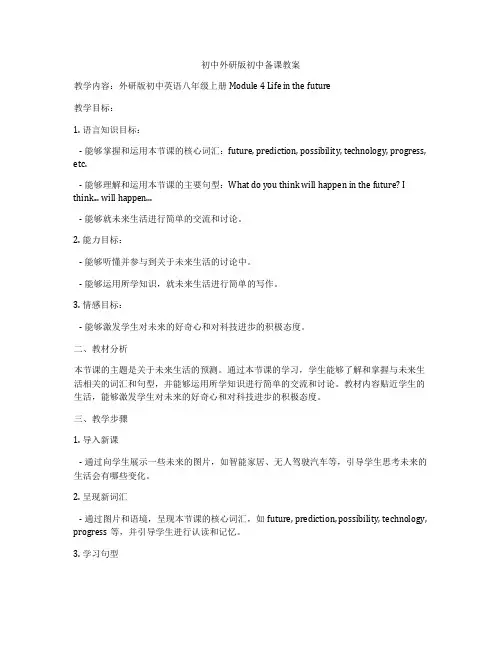
初中外研版初中备课教案教学内容:外研版初中英语八年级上册 Module 4 Life in the future教学目标:1. 语言知识目标:- 能够掌握和运用本节课的核心词汇:future, prediction, possibility, technology, progress, etc.- 能够理解和运用本节课的主要句型:What do you think will happen in the future? I think... will happen...- 能够就未来生活进行简单的交流和讨论。
2. 能力目标:- 能够听懂并参与到关于未来生活的讨论中。
- 能够运用所学知识,就未来生活进行简单的写作。
3. 情感目标:- 能够激发学生对未来的好奇心和对科技进步的积极态度。
二、教材分析本节课的主题是关于未来生活的预测。
通过本节课的学习,学生能够了解和掌握与未来生活相关的词汇和句型,并能够运用所学知识进行简单的交流和讨论。
教材内容贴近学生的生活,能够激发学生对未来的好奇心和对科技进步的积极态度。
三、教学步骤1. 导入新课- 通过向学生展示一些未来的图片,如智能家居、无人驾驶汽车等,引导学生思考未来的生活会有哪些变化。
2. 呈现新词汇- 通过图片和语境,呈现本节课的核心词汇,如future, prediction, possibility, technology, progress等,并引导学生进行认读和记忆。
3. 学习句型- 通过例句和练习,教授本节课的主要句型:What do you think will happen in the future?I think... will happen...,并引导学生进行模仿和练习。
4. 小组讨论- 将学生分成小组,让他们就未来生活进行讨论,鼓励他们用所学词汇和句型进行交流。
5. 听力练习- 播放一段关于未来生活的听力材料,要求学生听后回答相关问题。
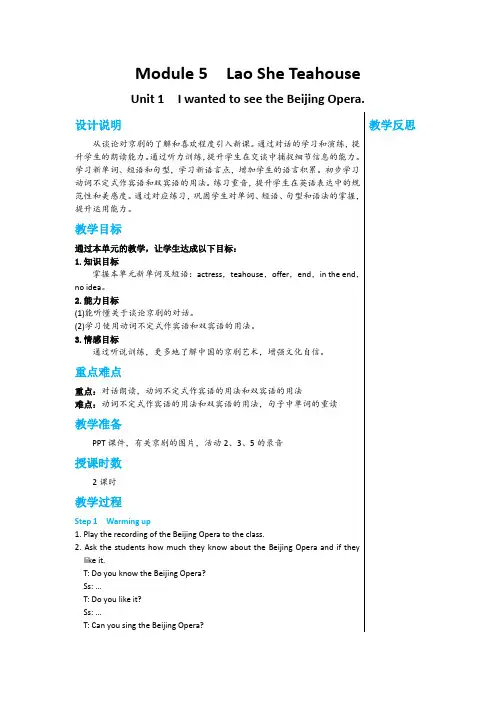
Module 5Lao She TeahouseUnit 1I wanted to see the Beijing Opera.设计说明教学反思从谈论对京剧的了解和喜欢程度引入新课。
通过对话的学习和演练,提升学生的朗读能力。
通过听力训练,提升学生在交谈中捕捉细节信息的能力。
学习新单词、短语和句型,学习新语言点,增加学生的语言积累。
初步学习动词不定式作宾语和双宾语的用法。
练习重音,提升学生在英语表达中的规范性和美感度。
通过对应练习,巩固学生对单词、短语、句型和语法的掌握,提升运用能力。
教学目标通过本单元的教学,让学生达成以下目标:1.知识目标掌握本单元新单词及短语:actress,teahouse,offer,end,in the end,no idea。
2.能力目标(1)能听懂关于谈论京剧的对话。
(2)学习使用动词不定式作宾语和双宾语的用法。
3.情感目标通过听说训练,更多地了解中国的京剧艺术,增强文化自信。
重点难点重点:对话朗读,动词不定式作宾语的用法和双宾语的用法难点:动词不定式作宾语的用法和双宾语的用法,句子中单词的重读教学准备PPT课件,有关京剧的图片,活动2、3、5的录音授课时数2课时教学过程Step 1Warming up1. Play the recording of the Beijing Opera to the class.2. Ask the students how much they know about the Beijing Opera and if theylike it.T: Do you know the Beijing Opera?Ss: …T: Do you like it?Ss: …T: Can you sing the Beijing Opera?Ss: …Step 2PresentationWork in pairs. Look at the pictures and talk about them. Use the words in the box to help you. (Activity 1 on Page 34)1. Ask the students to look at the pictures.2. Tell them to read through the words and make sure they know the meaningactress dance music play sing teahouse theatre traditional3. Ask them to describe the pictures in pairs.4. Encourage some pairs to present their conversations.Step 3Listening1. Let the students listen and underline the correct words or expressions. (Activity 2 on Page 34)(1) Ask the students to read the three sentences.(2) Play the recording and ask the students to choose the correct answers.(3) Have the students check answers with their partners.(4) Check answers and read full sentences with the students.Answers: 1 wants to see 2 doesn’t know 3 difficult(5) Play the recording again. Show the tapescript if necessary.Step 4Listening and reading1. Introduce the playwright Lao She and his play Teahouse to the class.2. Play the recording and ask the students to check the true sentences. (Activity3 on P35)(1) Read through the sentences and try to understand them.(2) Listen to the recording. Then check the true sentences.(3) Elicit the answers from the class.Answers: 3√4√5√3. Listen again and try to get answers to the question.1. Who went to Lao She Teahouse last night?2. Did Betty like the Beijing Opera?3. How long did they stay there in the end?4. Does Lingling often go to see the Beijing Opera?5. What is Lao She famous for?(1) Ask the students to read through the sentences and try to understand them.(2) Listen to the recording and try to get the answers. Allow some students toread the conversation if they still can’t get the answers after listening.(3) Elicit answers in full sentences for the class.Answers:1 Lingling and Betty.2 Yes, she did.3 They stayed there for three hours.4 No, she doesn’t.5 He is famous for his play Teahouse.4. Read the conversation again and find out the following phrases. Try to5. Listen to the conversation and read it.(1) Ask the students to listen to the recording and then try to read the conversation on their own.(2) Ask or encourage some students to read the conversation. Correct their mistakes.(3) Ask some students to practice the conversation in different roles.Step 5PracticeComplete the passage with the correct form of the words in the box. (Activity 4 on Page 35)(1) Read through the words in the box.complete it with the correct form of the words in the box on their own.(3) Check answers in groups.(4) Elicit answers from the class.Answers:(1) offered (2) difficult(3) actresses (4) end (5) mainStep 6Language points1. You know,I wanted to see the Beijing Opera,so Lingling offered to take me there. 你知道,我想看京剧,因此玲玲主动提出带我去那儿。
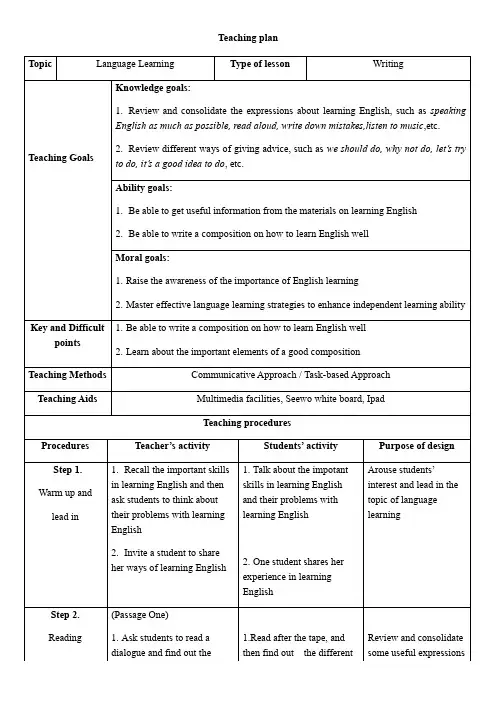
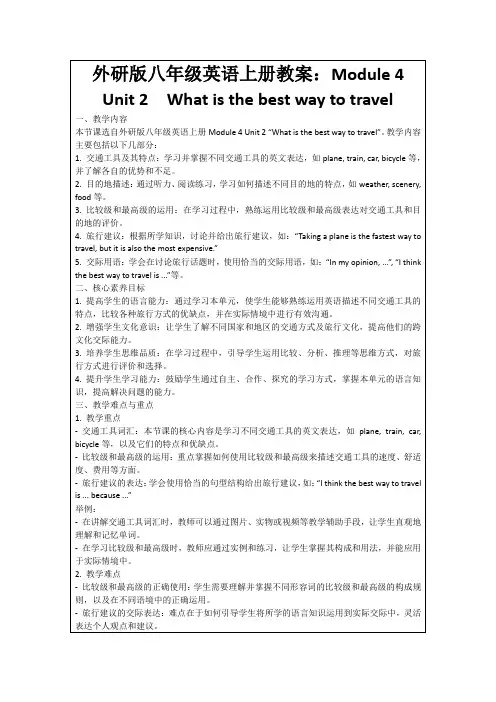
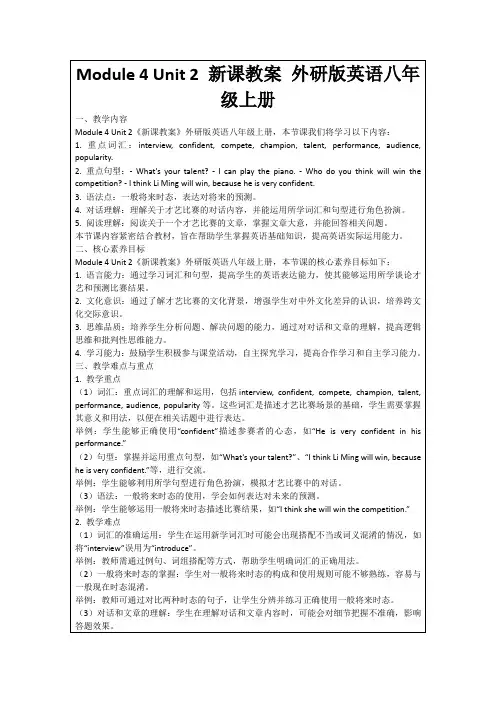
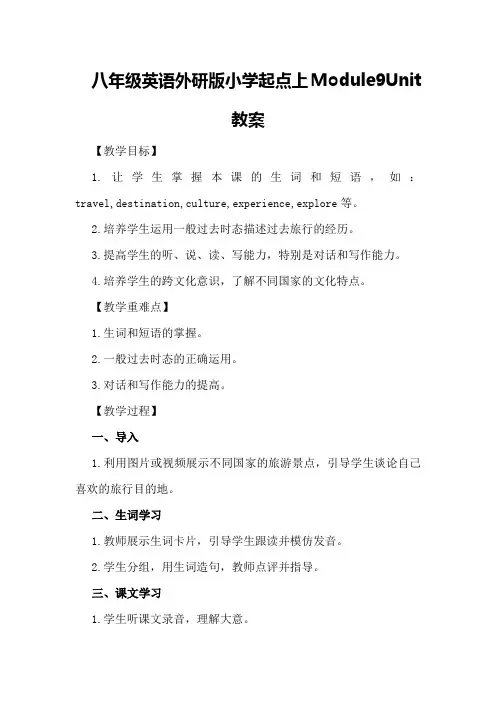
八年级英语外研版小学起点上Module9Unit教案【教学目标】1.让学生掌握本课的生词和短语,如:travel,destination,culture,experience,explore等。
2.培养学生运用一般过去时态描述过去旅行的经历。
3.提高学生的听、说、读、写能力,特别是对话和写作能力。
4.培养学生的跨文化意识,了解不同国家的文化特点。
【教学重难点】1.生词和短语的掌握。
2.一般过去时态的正确运用。
3.对话和写作能力的提高。
【教学过程】一、导入1.利用图片或视频展示不同国家的旅游景点,引导学生谈论自己喜欢的旅行目的地。
二、生词学习1.教师展示生词卡片,引导学生跟读并模仿发音。
2.学生分组,用生词造句,教师点评并指导。
三、课文学习1.学生听课文录音,理解大意。
2.教师提问,检查学生对课文的理解。
3.学生分角色朗读课文,注意语音、语调。
4.教师讲解课文中的难点和重点句子。
四、语法学习1.教师讲解一般过去时态的用法和构成。
2.学生完成练习,巩固一般过去时态。
3.学生用一般过去时态描述自己的旅行经历,教师点评并指导。
五、对话练习1.学生分组,模拟课文中的对话。
2.教师巡回指导,纠正发音和语法错误。
3.学生展示对话,其他学生评价。
六、写作练习1.教师提出写作任务:描述一次难忘的旅行经历。
2.学生讨论写作思路,列出要点。
3.学生独立完成作文,教师点评并指导。
七、拓展活动1.学生分组,设计一次旅行计划,包括目的地、行程、预算等。
2.各组展示旅行计划,其他学生提问或给出建议。
八、课堂小结1.教师回顾本节课的学习内容,检查学生对知识点的掌握。
2.学生分享学习心得,提出疑问。
3.教师布置作业,要求学生复习课文和生词。
【作业布置】1.复习课文和生词,熟读课文。
2.完成课后练习,巩固一般过去时态。
3.准备下一次课的对话和写作内容。
【教学反思】本节课通过生词学习、课文学习、语法学习、对话练习、写作练习和拓展活动等多种形式,让学生在轻松愉快的氛围中学习英语。
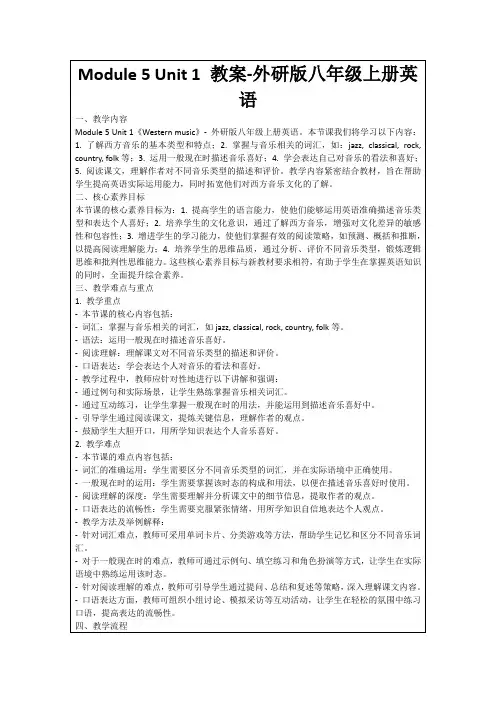
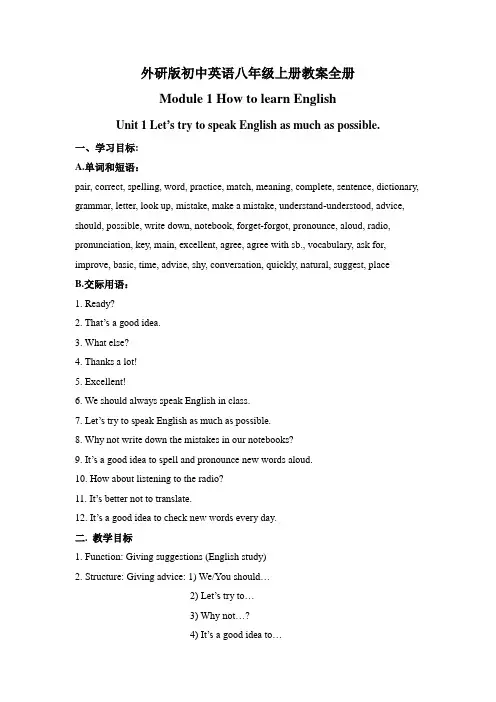
外研版初中英语八年级上册教案全册Module 1 How to learn EnglishUnit 1 Let’s try to speak English as much as possible.一、学习目标:A.单词和短语:pair, correct, spelling, word, practice, match, meaning, complete, sentence, dictionary, grammar, letter, look up, mistake, make a mistake, understand-understood, advice, should, possible, write down, notebook, forget-forgot, pronounce, aloud, radio, pronunciation, key, main, excellent, agree, agree with sb., vocabulary, ask for, improve, basic, time, advise, shy, conversation, quickly, natural, suggest, placeB.交际用语:1. Ready?2. That’s a good idea.3. What else?4. Thanks a lot!5. Excellent!6. We should always speak English in class.7. Let’s try to speak English as much as possible.8. Why not write down the mistakes in our notebooks?9. It’s a good idea to s pell and pronounce new words aloud.10. How about listening to the radio?11. It’s better not to translate.12. It’s a good idea to check new words every day.二. 教学目标1. Function: Giving suggestions (English study)2. Structure: Giving advice: 1) We/You sh ould…2) Let’s try to…3) Why not…?4) It’s a good idea to…5) How about…?6) Why don’t we/you…?7) It’s better not to…3. Skills: 1) Listening and understanding familiar topics (English study).2) Talking about problems in English study and giving advice, conductingconversations in several turns.3) Reading and finding specific information about English study.4) Drafting a letter asking for advice about English study, revising throughpair discussion..4. Around the world: English online5. Task: Writing your English study plan.三、重点及难点:Giving advice: 1) We/You should…2) Let’s try to…3) Why not…? 4) It’s a good idea to…5) How about…? 6) Why don’t we/you…? 7) It’s better not to…四、教学设计:Unit 1 Let’s try to speak English as much as possible.ⅠTeaching modelListening and speakingⅡTeaching methodPWP approachⅢTeaching aims1. To understand conversations involving advice on learning English.2. To get information about how to learn English from the conversation.3. To understand the way of giving advice.4. To practise giving advice on English learning.ⅣTeaching Objectives1. Key vocabulary: pair, correct, spelling, word, practice, match, meaning, complete,sentence, dictionary, grammar, letter, look up, mistake, make amistake, understand-understood, advice, should, possible, writedown, notebook, forget-forgot, pronounce, aloud, radio, key, main,excellent, agree, agree with sb., vocabulary2. Key structures: 1) We/You should…2) Let’s try to…3) Why not…? 4) It’s a good idea to…5) How about…? 6) Why don’t we/you…? 7) It’s better not to…ⅤTeaching aidsTape recorder, OHP , videoⅥTeaching StepsStep 1 Warming up1. Show some pictures of school things. Say how to learn English well.2. Read the words after the teacher.3. Introduce the new words.4. Learn the new words.Step 2 Read and check.1. Read the instructions in Activity 1and check(√) the ones you understand.1) Work in pairs. Ask and answer the questions.2) Correct the spelling.3) Listen and check the words you hear.4) Practise saying the words.5) Match the words with the meaning.6) Complete the sentences with the words in the box.3. Ask the students to check their answer with a partner.4. Call back the answer from the whole class and check the answer.Step 3 Listen and repeat.1. Ask the students to read the word and expressions in Activity2.dictionary grammar letter look up make a mistake meaning understand 2. Read through the questions.1) Which word did Daming not understand?2) What mistake did Lingling make?3) How does Daming usually check the spelling of a word?4) Why is it difficult for Daming to check the spelling of cinema?3. Play the recording and ask the students to listen to the recording carefully.4. Listen and answer the questions. Use the words and expressions from the box.5. Play the recording again, then they can check their answer with a partner.6. Call back the answer from the whole class and check the answer.Step 4 Listen and read.1. Show some pictures, and ask the students to talk about them.2. Ask the students to read the conversation silently.3. Play the recording and ask the students to listen and read the conversation.4. Read the conversation.5. Act it out.6. Learn “Everyday English”Ready?That’s a good idea.What else?Thanks a lot!Excellent!7. Tell the students how to learn English well.1) We should always speak English in class.2) Let’s try to speak English as much as possible.3) Why not write down the mistakes in our notebooks?4) Don’t forget to write down the correct answers next to the mistakes.5) It’s a good idea to spell and pronounce new words aloud every day.6) How about listening to the radio?7) How about reading English stories?8) W hy don’t we try to find some English pen friends?Step 5 Writing.1. Read the conversation again.2. Ask the students to write notes about learning English.Listening : listen to the radioSpeaking : ___________________________________________________ Reading : ____________________________________________________Writing: ____________________________________________________ Learning new words: ___________________________________________3. Ask the students to check with a partner.4. Check the answers:Keys:Listening : listen to the radioSpeaking : speak English as much as possibleReading : read an English storiesWriting: write to pen friends, write down our mistakes in our notebooks, write down the correct answers next to the mistakesLearning new words: spell and pronounce new words aloud every dayStep 6 Underline the correct words and expressions.1. Ask the students to read through the passage in Activity 4.Here’s my (1) advice / notebook about learning English. Speak English (2) always / as much as possible in class, and listen to English (3) in the newspaper / on the radio. I (4) agree / forget it’s a good idea to look up n ew worlds in the ( 5) notebook / dictionary. You can find the (6) correct / excellent pronunciation and learn the meaning2. Underline the correct words and expressions.3. Check with a partner.4. Call back the answers from the whole class.Keys: 1. advice 2. as much as possible 3. on the radio 4. agree 5. dictionary 6. correct 5. Read the passage together.Step 7 Listen and repeat.1. Play the recording once without stopping.2. Play the recording again and ask the whole class to repeat.1) We should always speak English in class.2) Let’s try to speak English as much as possible.3) Why not write down the mistakes in our notebooks?4) It’s a good idea to spell and pronounce new words aloud.5) How about listening to the radio?3. Ask the students to listen and mark the intonation.4. Now listen again and repeat.Step 8 Work in pairs.1. Talk about problems and give advice.Problems AdviceI can’t… How / What about …?I don’t know… Why not / don’t you …?2. Read through the example with the class.—I can’t speak English well. What should I do?—Why don’t you try to talk to our classmates in English?3. Work in pairs.Step 9 Important and difficult points1 Why not write down our mistakes in our notebooks?何不在笔记本上把我们的错误记下来?Why not …? 用来表示提出某种建议,而不是询问为什么不做某事的原因,例如:Why not take a walk in the park ?何不在公园里散散步?我们还可以用下面的表达方式来提建议:Why don’t we drive t o the country?我们何不开车去乡下?What / How about going to Europe for a holiday?去欧洲度假怎么样?Write down 或者put down 表示“记下,写下”。
外研版八年级英语的教学计划在做工作计划时要认真思考,好的工作计划应像目录树一样,层次分明,环环相扣,是一个完整的体系。
用完整的工作计划去指导我们的工作,这里给大家分享一些关于外研版八年级英语的教学计划,方便大家学习。
外研版八年级英语的教学计划1一、指导思想与教学总目标以“英语课程标准”为宗旨,适应新课程改革的需要,面向全体学生,提高学生的人文素养,增强实践能力和创新精神。
正确把握英语学科特点,积极倡导合作探究的学习方式。
培养学生积极地情感态度和正确的人生价值观,提高学生综合素质为学生全面发展和终身发展奠定基础。
要求学生有较明确的英语学习动机和积极主动的学习态度。
能听懂教师对有关熟悉话题的陈述并能参与讨论。
能读供七至八年级学生阅读的简单读物和报纸杂志,克服生词障碍,理解大意。
能根据阅读目的运用适当的阅读策略。
能与他人合作,解决问题并报告结果,共同完成学习任务。
能在学习中互相帮助,克服困难。
能合理计划和安排学习任务,积极探索适合自己的学习方法。
在学习和日常交际中能注意到中外文化的差异。
二、教材简要分析八年级英语下册共十个单元,每单元设计一个话题,并以此为中心,通过语言结构、功能项目为主线展开,采用任务型语言教学方式,以循序渐进的生活化的学习程序引导学生学会运用英语,有目的地做事。
新教材中设计了许多活动,如填写问卷、调查、访谈、书信、邮件往来等,使学生在语言学习中更好地体验、实践、参与、合作与交流,同时增加了学生在课堂上的互动,为任务型教学创造了条件。
同一话题随着学习的深入,内容不断充实,通过“滚动”呈现学习,不断深化。
如提建议话题,在七年级出现,在本教材Unit8也“滚动”呈现,支持话题的“任务”、“活动”也不断“升级”,伴随语言学习不断从“低级”走向“高级”,贯穿于教材始终。
此外,教材中每个单元设计的Pair work、Group work、Survey及Game为课堂活动提供了丰富的资源。
每个单元以一个话题为中心,分设Section A,Section B和Self check三个部分,自成一体,又相互照应:Section A是单元基本语言内容的呈现,Section B是语言知识的扩展、深化与运用,是Section A的延伸。
外研版英语(新标准)八年级上册教案Module 1 How to learn EnglishUnit 1 Let’s try to speak English as much as possible.一、学习目标:A.单词和短语:pair, correct, spelling, word, practice, match, meaning, complete, sentence, dictionary, grammar, letter, look up, mistake, make a mistake,understand-understood, advice, should, possible, write down, notebook, forget-forgot, pronounce, aloud, radio, pronunciation, key, main, excellent, agree, agree with sb., vocabulary, ask for, improve, basic, time, advise, shy, conversation, quickly, natural, suggest, placeB.交际用语:1. Ready?2. That’s a good idea.3. What else?4. Thanks a lot!5. Excellent!6. We should always speak English in class.7. Let’s try to speak English as much as possible.8. Why not write down the mistakes in our notebooks?pell and pronounce new words aloud.9. It’s a good idea to s10. How about listening to the radio?11. It’s better not to translate.12. It’s a good idea to check new words every day.二. 教学目标1. Function: Giving suggestions (English study)2. Structure: Giving advice: 1) We/You sh ould…2) Let’s try to…3) Why not…?4) It’s a good idea to…5) How about…?6) Why don’t we/you…?7) It’s better not to…3. Skills: 1) Listening and understanding familiar topics (English study).2) Talking about problems in English study and giving advice,conductingconversations in several turns.3) Reading and finding specific information about English study.4) Drafting a letter asking for advice about English study, revisingthrough pair discussion..4. Around the world: English online5. Task: Writing your English study plan.三、重点及难点:Giving advice: 1) We/You should…2) Let’s try to…3) Why not…? 4) Itgood idea to…5) How about…? 6) Why don’t we/you…? 7) It’s better no 四、教学设计:Unit 1 Let’s try to speak English as much as possible.ⅠTeaching modelListening and speakingⅡTeaching methodPWP approachⅢTeaching aims1. To understand conversations involving advice on learning English.2. To get information about how to learn English from the conversation.3. To understand the way of giving advice.4. To practise giving advice on English learning.ⅣTeaching Objectives1. Key vocabulary: pair, correct, spelling, word, practice, match, meaning,complete, sentence, dictionary, grammar, letter, look up,mistake, make a mistake, understand-understood, advice,should, possible, write down, notebook, forget-forgot,pronounce, aloud, radio, key, main, excellent, agree, agreewith sb., vocabulary2. Key structures: 1) We/You should…2) Let’s try to…3) Why not…? 4 good idea to…5) How about…? 6) Why don’t we/you…? 7) It’s better no ⅤTeaching aidsTape recorder, OHP , videoⅥTeaching StepsStep 1 Warming up1. Show some pictures of school things. Say how to learn English well.2. Read the words after the teacher.3. Introduce the new words.4. Learn the new words.Step 2 Read and check.1. Read the instructions in Activity 1and check(√) the ones you understand.1) Work in pairs. Ask and answer the questions.2) Correct the spelling.3) Listen and check the words you hear.4) Practise saying the words.5) Match the words with the meaning.6) Complete the sentences with the words in the box.3. Ask the students to check their answer with a partner.4. Call back the answer from the whole class and check the answer.Step 3 Listen and repeat.1. Ask the students to read the word and expressions in Activity2. dictionary grammar letter look up make a mistake meaning understand2. Read through the questions.1) Which word did Daming not understand?2) What mistake did Lingling make?3) How does Daming usually check the spelling of a word?4) Why is it difficult for Daming to check the spelling of cinema?3. Play the recording and ask the students to listen to the recording carefully.4. Listen and answer the questions. Use the words and expressions from the box.5. Play the recording again, then they can check their answer with a partner.6. Call back the answer from the whole class and check the answer.Step 4 Listen and read.1. Show some pictures, and ask the students to talk about them.2. Ask the students to read the conversation silently.3. Play the recording and ask the students to listen and read the conversation.4. Read the conversation.5. Act it out.6. Learn “Everyday English”Ready?That’s a good idea.What else?Thanks a lot!Excellent!7. Tell the students how to learn English well.1) We should always speak English in class.2) Let’stry to speak English as much as possible.3) Why not write down the mistakes in our notebooks?4) Don’t forget to write down the correct answers next to the mistakes.spell and pronounce new words aloud every day.5) It’s a good idea to6) How about listening to the radio?7) How about reading English stories?we try to find some English pen friends?8) Why don’tStep 5 Writing.1. Read the conversation again.2. Ask the students to write notes about learning English.Listening : listen to the radioSpeaking : ___________________________________________________ Reading : ____________________________________________________ Writing: ____________________________________________________ Learning new words: ___________________________________________3. Ask the students to check with a partner.4. Check the answers:Keys:Listening : listen to the radioSpeaking : speak English as much as possibleReading : read an English storiesWriting: write to pen friends, write down our mistakes in our notebooks, writedown the correct answers next to the mistakesLearning new words: spell and pronounce new words aloud every dayStep 6 Underline the correct words and expressions.1. Ask the students to read through the passage in Activity 4.Here’s my (1) advice / notebook about learning English. Speak English (2) always / as much as possible in class, and listen to English (3) in the newspaperew worlds in the/ on the radio. I (4) agree / forget it’s a good idea to look up n ( 5) notebook / dictionary. You can find the (6) correct / excellent pronunciation and learn the meaning2. Underline the correct words and expressions.3. Check with a partner.4. Call back the answers from the whole class.Keys: 1. advice 2. as much as possible 3. on the radio 4. agree 5. dictionary 6. correct 5. Read the passage together.Step 7 Listen and repeat.1. Play the recording once without stopping.2. Play the recording again and ask the whole class to repeat.1) We should always speak English in class.2) Let’s try to speak English as much as possible.3) Why not write down the mistakes in our notebooks?4) It’s a good idea to spell and pronounce new words aloud.5) How about listening to the radio?3. Ask the students to listen and mark the intonation.4. Now listen again and repeat.Step 8 Work in pairs.1. Talk about problems and give advice.Problems AdviceI can’t… How / What about …?I don’t know… Why not / don’t you …?2. Read through the example with the class.—I can’t speak English well. What should I do??—Why don’t you try to talk to our classmates in English3. Work in pairs.Step 9 Important and difficult points1 Why not write down our mistakes in our notebooks?何不在笔记本上把我们的错误记下来?Why not …? 用来表示提出某种建议,而不是询问为什么不做某事的原因,例如:Why not take a walk in the park ?何不在公园里散散步?我们还可以用下面的表达方式来提建议:Why don’t we drive to the country?我们何不开车去乡下?What / How about going to Europe for a holiday?去欧洲度假怎么样?Write down 或者put down 表示“记下,写下”。
外研版英语八年级上册Module 6《Animals in danger》(Unit 2)教学设计一. 教材分析《Animals in danger》是人教版英语八年级上册Module 6的第二单元,本节课主要讨论动物保护的问题。
教材通过介绍濒危动物,让学生学会谈论动物的特点以及保护动物的重要性。
内容主要包括对话和阅读材料,对话内容是围绕两个学生在讨论他们最喜欢的动物,并讨论了动物濒危的原因。
阅读材料是一篇关于大熊猫的文章,介绍了大熊猫的生活习性和保护现状。
二. 学情分析八年级的学生已经具备了一定的英语基础,能够进行简单的英语交流。
但他们在阅读和写作方面还存在一定的困难,因此需要教师耐心引导,逐步提高他们的阅读和写作能力。
此外,学生对于动物保护这个话题可能比较感兴趣,因此教师可以利用学生的兴趣,激发他们的学习积极性。
三. 教学目标1.知识目标:学生能够掌握有关动物的词汇和表达方式,如endangered, habitat, protection等;学生能够理解对话和阅读材料的内容,并能够进行简单的交流和讨论。
2.能力目标:学生能够运用所学的词汇和句型进行阅读和写作,提高阅读和写作能力。
3.情感目标:学生能够认识到保护动物的重要性,增强环保意识。
四. 教学重难点1.重点:学生能够掌握有关动物的词汇和表达方式,理解对话和阅读材料的内容。
2.难点:学生能够运用所学的词汇和句型进行阅读和写作,提高阅读和写作能力。
五. 教学方法1.任务型教学法:通过设置各种任务,让学生在完成任务的过程中学习和运用英语。
2.情境教学法:通过创设情境,让学生在真实的环境中学习和运用英语。
3.小组合作学习:通过小组讨论和合作,提高学生的参与度和合作能力。
六. 教学准备1.教师准备教材、教案、课件等教学材料。
2.学生准备课本、笔记本等学习用品。
七. 教学过程1.导入(5分钟)教师通过向学生展示一些濒危动物的图片,引导学生谈论动物保护的话题。
Module 7 A famous storyUnit 1 Alice was sitting with her sister by the river.设计说明教学反思本单元以谈论《爱丽丝漫游奇境记》一书及其作者引入新课。
通过听力练习和对话演练,提升学生的听说和朗读能力。
学习本模块的新单词、短语和句型,学习新语言点,增加学生的语言积累。
从本模块开始学习一个新的时态——过去进行时,在初步学习时从一般过去时和现在进行时引入过去进行时,做好这三个时态的区别。
练习朗读中的重读,提升学生在英语口语表达中的规范性和美感度。
通过对应练习,巩固学生对单词、短语、句型和语法的掌握,提升运用能力。
教学目标通过本单元的教学,让学生达成以下目标:1. 知识目标掌握本单元新单词及短语:fall, follow, hole, rabbit, ssh, ground, tea party。
2. 能力目标(1)能够听懂关于谈论童话故事的对话;用正确的语音、语调朗读对话;(2)学习过去进行时的基本用法。
3. 情感目标通过阅读童话故事及中英文名著的介绍,了解西方国家的文化,汲取其精华。
重点难点重点:对话朗读;过去进行时。
难点:过去进行时。
教学准备PPT课件;《爱丽丝漫游奇境记》及其作者图片;活动1、2、3、5的录音授课时数2课时教学过程Step 1Leading inDiscussion.T: Boys and girls. Do you like reading stories?Ss: Yes, we do.T: Stories are usually interesting. I enjoyed them very much when I was a child.Do you know the book Alice’s Adventures in Wonderland ?Ss: …T: Oh, some children have read the book. Who can tell us something about thebook or the story?Ss: …Show some pictures about the story and its author.Give more information to the class at the same time.Alice’s Adventures in Wonderland is a famous English storybook.Children all over the world like reading it.The English writer Lewis Carroll wrote Alice’sAdventures in Wonderland in the 1960s. The story is also calledAlice in Wonderland.The story is about a girl called Alice. It tells her strange andinteresting experiences in wonderland.Alice, the Cheshire Cat, the March Hare, the Queen of Hearts andthe Mad Hatter are main characters of the story.Step 2Listening1. Finish Activity 1. Listen and number the words as you hear them.(1) Ask someone to read the words. Make sure that all the students understand the meaning.fall follow hole rabbit strange(2) Play the recording and ask the students to write down the numbers 1-5 in the boxes, according to what they hear.(3) Check the answers together.Answers:fall—4; follow—2; hole—5; rabbit—3; strange—12. Finish Activity 2. Listen again and number the pictures.(1) Read the simple descriptions of the pictures to the class. Repeat the names for the students to remember.(2) Ask some students to read the descriptions and the other students to look at the pictures.(3) Play the recording for students and ask them to number the pictures.(4) Check the answers together.Answers:a—2; b—3; c—1(5) Play the recording again. Show the tapescript if necessary.Step 3Listening and readingFinish Activity 3.1. Play the recording. Tell the students to read the conversation as they listen.2. Ask the students to check (√) the true sentences, according to the conversation.1. Lingling is reading Alice’s Adventures in Wonderland. ( )2. The book is about a girl called Alice. ( )3. One day, Alice and her sister saw a white rabbit with a basket.( )4. The March Hare, the Mad Hatter and a mouse were having a tea partyin the garden. ( )5. The Queen of Hearts was sitting in a tree. ( )Answers:1. √ 2. √ 4. √3. Read and complete the notes.1 Alice was ________ with her ________ by the river.2 The white rabbit with a ________ ran past.3 The Mad Hatter, the March Hare and a mouse were having a ________ party.4 The Queen of Hearts was ________ a strange game.(1) Ask the students to read the sentences carefully.(2) Ask them to read the conversation again. Underline the key information while reading.(3) Get the students to complete the sentences from the conversation.(4) Check the answers.Answers:1 sitting, sister2 watch3 tea4 playing4. Read the following phrases and translate them into Chinese.1 one day2 by the river3 fall down4 in a tree5 smile at6 tea party7 play games8 a girl called Alice9 run pastAsk the students to write down the phrases on their notebooks.5. Read the conversation.(1) Ask the students to follow the recording to read the conversation.(2) Tell them to work in pairs. One is Tony, and the other is Daming.(3) Encourage some pairs to read the conversation in different roles.Step 4PracticeFinish Activity 4. Complete the sentences with the words in the box.1 Something is ________ if it is not usual.2 You ________ when you are happy.3 You can wear a ________. It tells you the time.4 A rabbit ________ is a place where rabbits live.5 You ________ when you move down quickly to the ground.(1) Ask the students to read through the words in the box. Make sure they know the meaning of the words.(2) Ask the class to read the sentences and complete them with the words in the box on their own.(3) Check the answers in groups.Answers:1 strange2 smile3 watch4 hole5 fallStep 5Language points1. One day, Alice was sitting with her sister by the river and she saw a white rabbit with a watch. 有一天,爱丽丝正和她的姐姐坐在河边,她看到一只戴着手表的白兔。
外研版英语八年级教案
外研版英语八年级教案1
【学习目标】
1.知识目标:学习反义疑问句的用法
2.技能目标:提高学生的听说以及闲聊在英语表达中的定义和操练。
3.情感目标:了解聊天的文化知识。
【重点、难点】
掌握反义疑问句的运用。
【导学指导】
温故知新复习短语
go swimming 去游泳wait in line 排队hate doing sth. 讨厌做某事
So am / do I 我也是。
It looks like rain 看上去要下雨了。
wait for the bus/ train 等车be late for/to 迟到
I hope so/not. 我希望如此/我不希望这样。
自主互助学习
1、学生观察1a中的图片相互提问:A:what can you see in picture 1?
B: I can see……. A:What are they doing? B: They are …….(学生通过相互提问熟悉图画内容,为听力做准备。
)
2、教师让学生归纳1a-2c中所出现的反意疑问句,让学生观察、总结反意疑问句的构成。
知识剖析: 反意疑问句要点简述反意疑问句又叫附加疑问句,是在陈述句后,对陈述句所叙述的事实提出的疑问。
其基本结构有两种:一是“肯定陈述句+简略否定问句”;
二是“否定陈述句+简略肯定问句”。
反意疑问句的前后两部分在时态、人称和数上都要保持一致。
如:It looks like rain, doesn’t it?
He doesn’t need to work so late, does he?
几种特殊情况:
1. 陈述部分是there be 句型,疑问部分也用there be 句型。
There is a book on the desk, isn’t there?
2. 陈述部分如有nothing, nobody, never, few, little, hardly
等否定词时(不包括加否定前缀变来的,如:dislike, unhappy等),疑问部分用肯定形式。
They have never been to the farm, have they?
There is little water in the glass, is there?
He dislikes history, doesn’t he?
3. 陈述部分为祈使句时,反义部分用will you , won’t you 。
以Let’s开头的祈使句,疑问部分用shall we .
Go to the cinema now, will you?
Let’s have a party, shall we?
4. 陈述部分含宾语从句时,疑问部分一般反问主句,但主句含有I/We think/believe/suppose … 时,疑问部分要反问从句(要注意否定转移情况)。
He knew that the woman was a thief, didn’t he ?
I don’t think he is a good student, is he?
外研版英语八年级教案2
课堂作业
I. Match the sentences
( )1. Could I speak to Sam,please?
( )2. Would you like to come to my birthday party tonight? ( )3. May I come in?
( )4. What about going out for a walk?
( )5. Shall I open the door?
( )6. Will you (please) lend your pen to me?
a. Good idea!
b. Yes,please.
c. Certainly. Hold on,please.
d. I’d love to.
e. Sorry,I’m afraid not.
f. Come in,please.
II. Translate the sentences into English.。